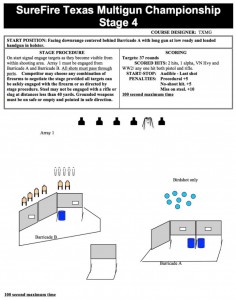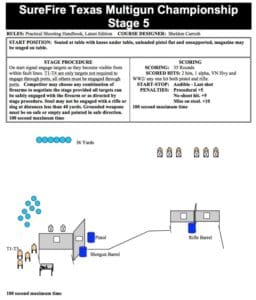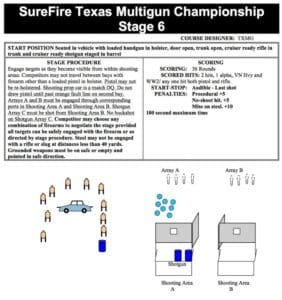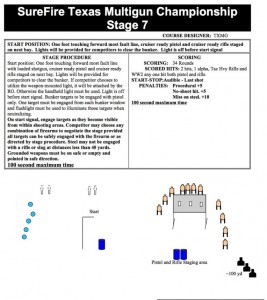Arriving at the range for the second day of the Texas Multigun 3-gun shoot, I was pretty jazzed. On day one I had a few fumbles, but made up for them with some solid rifle work. I was expecting the second day to be even better. But that just wasn’t in the cards . . .
The first stage started with some long range (~100 yards) steel shot from two different positions, followed by some shotgun work on pepper poppers, then a bunch of paper through an inconveniently high port. Finally, a bunch of pepper poppers needed knocking over with a handgun. Straightforward stage design with no real way to “game” things for a quicker time.
The only real concern was breaking the 180 rule, which prohibits shooters from pointing their gun anywhere except downrange. Running right to left with a long gun, it’s always a concern as your natural tendency (if you’re a righty) is to hold the gun across your body with the muzzle pointing left (AKA into the crowd).
But one of the stage features was particularly worrying. In order to engage some of the shotgun targets, you needed to move backwards from the dump barrel (where the gun is staged) to a port cut in one of the walls. If you pivot directly from the barrel and aim your gun into the port, you break 180 and are immediately sent home (the ROs took some pride in telling us they had DQ’d 10 people on the first day). The only way to do it safely was to move backwards, shotgun in hand but pointing downrange, until you could see through the port.
The rifle targets went pretty well. I missed a couple times, but that’s to be expected first thing in the morning with only a couple hours of sleep. Once again, I was shoving my rifle way too deep into the ports, taking an extra couple of seconds to get set up and then slowing me down as I tried to take it out of the port to move or ditch the gun. An extended handguard is on its way, which should help fix that situation.
The first array of shotgun targets went OK, but I should have ditched the shotgun there. The first group (5 targets) had to be hit with shotgun rounds, but the second array was far enough away that you could do it with either shotgun or handgun. I still had some concerns about my handgun shooting, so I figured reloading the shotgun and taking out the pepper poppers with that instead would be faster.
I was right, but the extra 3 to 4 seconds it took to reload plus the extra 3 to 4 seconds it took to safely dump the shotgun back in the barrel (which was now behind me) slowed me down considerably. This exact situation, where I needed to dump a shotgun into a barrel that was behind me, was what got me tossed from the Crimson Trace Midnight 3-gun shoot when I got lost and broke the 180 rule, so I wanted to be extra careful and take my time with this obstacle.
One area of improvement, though, was the “load two” reload I did while moving from one array to the next. I only picked the technique up last weekend, but it’s already paying off. That reload would have taken AGES if I had to use the old method.
The paper targets through uncomfortable ports were pretty easy thanks to my height. Smaller shooters needed to use the low ports, but I could step right up and shoot over those no-shoot targets. This stage actually had a wooden box that shooters could position wherever they wanted so they could use it to see through the ports. Some of the smaller shooters like Kay Miculek and her daughter Lena used it to see through that first shotgun port.
The steel handgun targets at the end of the stage were what made me reconsider my earlier choice to go with the shotgun on the pepper poppers. I only missed once on the last five steel targets, which were further away than that first array. If I could change one thing about my run, I definitely would have ditched the shotgun earlier.
The most annoying thing was that the first steel target refused to fall. I must have hit it a little low, because I heard the round hit, but it didn’t fall over. In 3-gun, the target needs to fall to count, so I eventually resorted to double tapping the thing to get enough momentum going to make it tip. Annoying, but par for the course for those running 9mm handguns.
My time: 82.35
Erik’s: 59.01
What annoyed me the most was that I was on pace to be close to Erik’s scores, but the little mistakes were adding up. Switching from using a shotgun to a handgun would have brought my time down to about 75. Not hitting low on that steel target, and remembering to reload before firing, would have sliced another five seconds off. I wasn’t pleased.
The next stage went pretty well. It was another straightforward design: shoot a bunch of steel shotgun targets, ditch the shotgun, shoot a bunch of long range rifle targets, run, shoot them again, ditch the shotgun, and then finish off some paper and pepper poppers with your handgun. This stage was run in a modified version at last month’s Best of the West 3-gun event (they were testing the design), so I knew what to do.
The shotgun was smooth, only needing to make up for one miss. While annoying, that one miss made me run dry at the end, so I didn’t have to worry about putting on the safety before ditching the shotgun. The rifle was good, too, but again, I was WAY too far into that port. A consequence of that was that the charging handle of the SCAR was giving my support hand some love taps, but I’m already working on a fix for that. No complaints with the handgun.
My time: 59.40
Erik’s time: 48.51
At this point in the competition I was feeling good. I was keeping pretty close pace with the rest of the team and while my inexperience was showing in my scores, it looked like I was on track to stay well within the top 100 shooters (there were 400 at the event). The next stage, though, began my slide toward the bottom.
We started seated at a table, handgun unloaded with a magazine staged on the table. At the buzzer you jump up, load the handgun and hose four targets before coming around to the side of an obstacle and shooting a bunch of small steel targets. That’s when the pain starts: a 36 yard shot at a rack of very small plates. Finally, the stage finishes with 6 targets that require headshots from around 30 yards.
I started the stage fine, pumping the first few targets with the required number of rounds before moving on. I had a touch of trouble with the small steel targets, but that falls under the same heading of “handgun needs work” that the rest of the match could be filed under. Once I was done with the handgun I had some trouble flipping on the safety, so instead I dropped the magazine and racked the slide to be extra sure the gun was empty.
For the plate rack, the option was given to use buckshot instead of handgun rounds to put the targets down, and I went for it — despite the fact that I had never fired buckshot through an SLP before. And that I only had 9 rounds. And that I was still using Erik’s shotgun, which had a different sighting system than my own. You can see where this is going.
I managed to knock down all but one of the steel targets on the plate rack, but then ran out of ammo. All I had left was birdshot, and I decided to give it a try anyway. At that point I should have cut my losses, taken the five second penalty and moved on. Instead, I sat there and tried to reload my shotgun twice before baling. I managed to turn a 5 second penalty into a 17 second morass.
The rest of the run was fine, but that one decision was the absolutely wrong call. Looking beyond the fact that I should have brought more ammo with me, I knew that birdshot wasn’t going to do the trick but I tried anyway. Twice. That poor decision cost me some serious time, and it hurt.
My time: 94.25
Erik’s: 27.24
That mistake put me in a definite funk. The organizers were posting the scores in real time and keeping a running tally of how everyone was doing. After that remarkably poor stage, I dropped to 147th place. Needless to say I wasn’t happy, and my mood was about to get worse.
We started the next stage in another car. You had to grab your rifle from the trunk before engaging a bunch of targets while retreating. This is another stage where it’s really easy to break that 180 rule, and they had a running tally on their white board of 7 people that had already been sent home from this one stage. After you engage the paper targets you ditch your rifle and run over to a second bay where there are a series of pepper poppers and some small steel targets that can be shot either with a handgun or a shotgun. There were two arrays of pepper poppers, and each one could only be engaged from a specified port.
The rifle section, again, was good. Like I said, I’ve had some experience hopping out of a car when starting a 3-gun stage, so no problems there. I tried my offset sights for the first time on the three close targets (I figured I couldn’t miss, and I wanted to see where they were hitting) and then booked it for the barrel before turning to engage the rest of the targets. Some people shot the targets on that right side of the bay as they passed them. Dianna even did it without looking down her sights, but I decided to play it safe.
When I ran to the second bay, that’s where my aversion to my handgun started to take its toll. I decided that I’d run the second bay 100% with my shotgun, leaving my handgun in its holster. The ROs said that I was the first person they had seen run it like that, and there’s a good reason for that. It was slow as all hell.
I had to run across the bay to grab my shotgun, wasting precious time as I moved from one side to the other, and then moved excruciatingly slowly on my way back once I had it. I could have probably run that section in half the time if I had used my handgun, but my fear of missing with the pistol made me change my game plan. Unfortunately, I would over-correct for that on the next stage.
My time: 69.11
Erik’s: 51.49
Stage 7 was the final stage of the day, and it was my turn to go first. In competition shooting, the squad rotates shooters so that everyone goes first on one stage and no one is forced to always be either first or last. Going first is considered a handicap, since you don’t get a chance to see others shoot the stage and see what works and what doesn’t. All you have is your own personal game plan.
The stage began with some more shotgun targets while retreating, followed by a short run to some long range steel (~130 yards) with your rifle. Then you have a choice of shooting some paper targets with a handgun or a rifle before grabbing your handgun and a Surefire flashlight to engage some targets that were in a blacked out box.
Sponsors love doing this kind of stuff, forcing shooters to use their products in some sort of specially designed stage to show off how awesome they are. Hell, that was the entire point of Crimson Trace’s Midnight 3-gun. In this case, it made me especially happy that I had an FNS-9, since the accessory rail under the handgun meant I could attach a Surefire light to it and keep my hands on my gun. Others who were sans rail needed to hold the flashlight with one hand and their gun with the other, something that definitely impacted their accuracy and speed.
I took the same tactic I used for the last stage and applied it here as well, sprinting to the dump barrel before engaging any of the targets. That kept me on the right side of the 180 rule, and so I was happy to spend an extra second or so in the bay compared to trying to hit them while walking backwards. I missed one target, though, which threw off my count and forced me to reload. Instead of heeding Mark’s words, I loaded two rounds instead of one and decided to double-tap the last target instead of flipping on the safety.
Technically, it’s an unsafe (and DQ-worthy) action to fire a round into the berm to clear your gun to avoid engaging the safety when there’s no target available. But if you intend to fire both shots, you’re cool. It’s a loophole large enough to drive Taran Butler through, but one you can take advantage of if you do it safely and quickly, like I did.
On the other side of the berm I was in my element: long range rifle shooting. Years of Olympic smallbore and NRA High Power competitions had perfected my ability to shoot offhand at distant targets. Except that I usually wasn’t doing it after sprinting 50 yards. I hit the first two targets right away, but the third proved elusive as my muscles started to weaken. I eventually got it, but I spent a good 7 seconds more than I should have.
The right plan would have been to use the barrel as a rest and shoot the targets while kneeling. During my walk-through I tried to see the targets from that position, but the berm in front of me seemed to block them. Other shooters would eventually prove me wrong. There really was sufficient clearance to shoot them off the barrel, but I didn’t have that information going first.
Shooting offhand was my first mistake, but not my biggest. That was dumping the rifle and using the handgun for the paper targets. The RO had said that the faster shooters had run the stage that way, and since my aversion to using my handgun had fouled up the last stage I figured it was worth a try. Big mistake: I missed twice. That added +10 seconds to my time, where running it with a rifle would have been cleaner AND faster.
Like I said, having a rail on your handgun really helps in cases like this. The rail mounted flashlight worked perfectly, and I mopped up the rest of the targets with ease.
My time: 80.25
Erik’s time: 55.22
As I packed up my gear and started the long trip home, I was in an awful mood. The mistakes I made weren’t from a lack of practice or firearms-related malfunctions; they were all due to the way I planned the stages. Strategic errors, not tactical ones. As I left for the day, I was still stuck in the low 140’s. I thought my match was over, that there was no way to get myself out of the hole I dug. And when I looked at the stage we’d be shooting first thing in the morning, my mood only worsened.
Stage 8 featured long range rifle fire, with two to three targets at 100, 200, 300, 400 and 500 yards (where all targets were a +20 second penalty if not hit). And I’d be using a scope I wasn’t used to. I’d also be shooting standard Winchester ammunition. I didn’t have anything fancier than the Winchester white box 55 grain ammo that Winchester sent me for practice. Everyone else was using Hornady match grade 77 grain rounds. I didn’t hold out much hope for improving my position, but I was about to be proven wrong. Yet again. This time, in a good way.









Nick, is there a reason the FNH-USA team doesn’t use any of the FS-2000s?
Also what about the Five-Seven? Theres more ammo in those 20/30 round magazines and I hear they are pretty accurate and controllable, I don’t know about knock down power compared to the 9mm though.
If for no.other reason the safety is abhorrent on therein
Short answer: the SCAR is the new hotness. They took the lessons learned from the FAL and the FS-2000, added some magic, and came out with what you see today. It’s better in almost every way.
As for the Five-seveN, the competition dictates a minimum caliber of 9mm. So the zippy 5.7mm bullets are a no-go.
Ahhhhh….Thanks Nick!!
I’m not a big fan of FN Herstal. Ever since they decided to make those horribly difficult to reload 5.7x28mm loaded in the popular and much desired FN five-seven. They decided they didn’t want to work with “the people” and only wanted to work with the US government and never provided the reloading data.
Youve definitely improved on the rifle shooting and pistol lately, do you practice more with the rifle/pistol than the shotgun or an even mix of all 3? I was hurtin for you during the shotgun stage of that last video with the 2 shots loaded into the chamber.
Ive really enjoyed watching these 3 gun videos as my opportunities training/competing have pretty much been assassinated by grad school.
Again I say, I love these videos. Keep it up!
I’m really enjoying the Team FN 3-gun coverage. Very much looking forward to the next installment.
I was just curious if you or anyone else has experimented with those short(1.75 I believe) shotgun shells to increase capacity and negate reloads during competition?
Shotgun capacity is limited by class, not by how much you can actually stuff in the gun. Open class can have any shotgun capacity they want(think X-Rail) while Limited and Tac Ops can only start a stage with 8+1 (total of 9) in the gun at the buzzer.
PLEASE CANCEL ALL E- MAILS TO ME ,GEO
Great coverage – love the insights! Gun competitions are like golf in the sense that if you have a bad hole in golf and don’t brush it off it bites you in the ass the rest of the way. Hard to do for us over thinkers though. I found distracting myself and refusing to think about the last stage is very difficult, sometimes I could never recover.
Comments are closed.